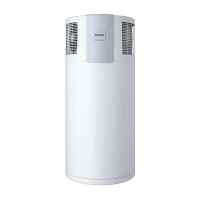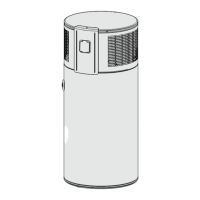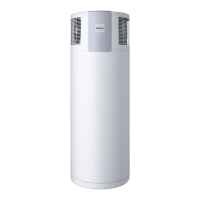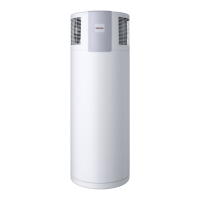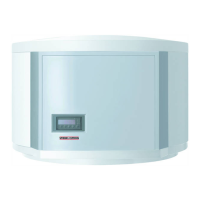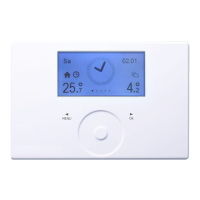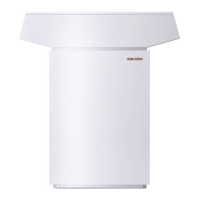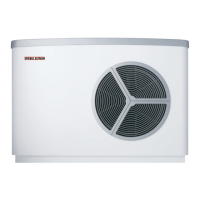www.stiebel-eltron.com WWK222-302 H | 11
INSTALLATION
Preparations
D0000034797
1
1
1 Recessed grips
Transport from vehicle to installation room
The cardboard box has reinforced handholds (recessed grips). You
can use these recessed grips, as well as the pallet at the lower
end, to carry the appliance into the installation room. Take note
of the weight of the appliance and ensure a sufficient number of
personnel is available for handling the appliance.
9.2 Storage
If it is necessary to store the appliance for a prolonged period
before installation, observe the following information:
- Only store the appliance in a vertical position. Never store
the appliance horizontally.
- Store the appliance in a location that is dry and largely
dust-free.
- Protect the appliance from coming into contact with corrosive
substances.
- Ensure the appliance is not subjected to shocks or vibrations.
9.3 Installation site
!
Material losses
Observe the following list of requirements regarding the
installation site.
- Install the appliance where it will be as little exposed to
strong direct wind, extrem rain, sun or snow as possible, but
will still be well ventilated. Unhindered air intake and air dis-
charge should be possible. If necessary, protect the appliance
against the elements with a canopy, base and deflectors.
- The installation site must be free from flammable, highly
combustible gases and substances, as well as high levels of
dust.
- The application limits for the heat pump and DHW cylinder
must be maintained (see chapter "Specification/ Data table").
- The substrate of the installation site must be level and have
sufficient load bearing capacity. Take note of the weight of
the appliance with a full DHW cylinder (see chapter "Speci-
fication/ Data table"). A floor with insufficient load bearing
capacity is in danger of collapse. If the appliance is not level,
there may be a risk of appliance damage.
- In the case of indoor installation, the size of the installation
room must correspond to the application limits of the appli-
ance (see chapter "Specification/ Data table").
- Observe the safety clearances and protection zones.
- Always leave sufficient space to provide access for installa-
tion, maintenance and cleaning. Observe the minimum clear-
ances (see "Preparations/ Siting the appliance").
- Ensure the operation of other equipment in the installation
room is not impaired.
- To keep the length of the water pipes as short as possible,
we recommend installing the appliance close to the kitchen
or bathrooms.
- To prevent adverse effects from operating noise, never install
the appliance close to bedrooms.
!
Material losses
Never install or draw off supply air from locations with
aggressive atmospheres. This may damage the appliance.
Check the wider environment around the planned
installation site. Check for anything which may have
adverse effects on the installation site or the air
supply.
Examples of unacceptable in-
stallations
Atmospheres containing ammonia sewage works, pigsties
Substances which block the evap-
orator
Air containing oil or fat, dust (cement,
flour, etc.). Note: If the air contains hair-
spray (e.g. in hairdressing salons) the
appliance should only be operated with
reduced maintenance intervals.
Saline atmospheres Coastal installations (< 200m from coast
line) may reduce the life of components.
atmospheres containing chlorine or
chloride
swimming pools, salt works
atmospheres containing thermal
water
Areas in proximity to high frequency
machines
inverters for large motors, radar, etc.
If the air contains hairspray (e.g. in hairdressing salons), the appli-
ance should only be operated with reduced maintenance intervals.
Note
The output data given for this appliance has been de-
termined in accordance with the relevant standard at an
intake temperature of 15°C. Below 15°C, the efficiency
of the appliance decreases.
Note
You can improve the efficiency of the appliance by utilis-
ing the waste heat from other appliances to heat the DHW
cylinder, e.g. boilers, tumble dryers or freezers.
Sound emissions
The sound emissions are louder on the air intake and air discharge
sides of the appliance than on the closed sides.
Never direct the air intake or air discharge towards
noise-sensitive rooms of the house, e.g. bedrooms.
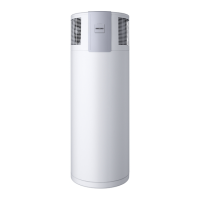
